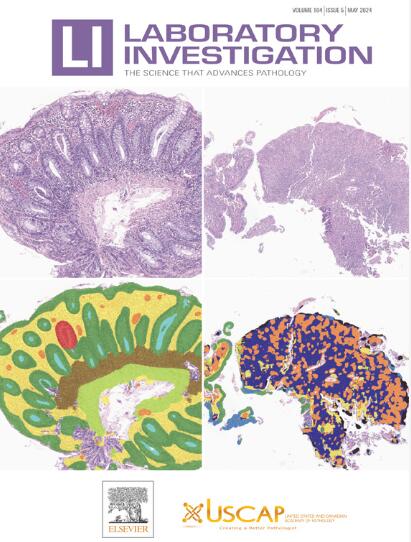Clinicopathologic, Cellular, and Molecular Analyses of Pulmonary Neuroendocrine Carcinoma With High Expression of Hepatocyte Nuclear Factor 4 Alpha
IF 4.2
2区 医学
Q1 MEDICINE, RESEARCH & EXPERIMENTAL
引用次数: 0
Abstract
Pulmonary neuroendocrine carcinoma (NEC), including small cell carcinoma (SCLC) and large cell neuroendocrine carcinoma (LCNEC), is highly aggressive and has a poor prognosis. The molecular subtyping of NECs has recently attracted attention, and we identified a new NEC subtype, the hepatocyte nuclear factor 4α (HNF4α) subtype. HNF4α, a transcription factor associated with gastrointestinal differentiation, and TTF-1 are mutually and exclusively expressed in lung adenocarcinomas; however, the characteristics of HNF4α-high NEC and TTF-1-high NEC have yet to be compared. We immunohistochemically examined the characteristics of HNF4α-high NEC in 83 surgically resected specimens (37 SCLCs and 46 LCNECs) and revealed that HNF4α-high and TTF-1-high NEC accounted for 15% (12/83) and 47% (39/83), respectively. In SCLCs, HNF4α-high cases (n = 3) and TTF-1-high cases (n = 20) were almost confined to the neuroendocrine phenotype with high ASCL1 expression, and the expressions of HNF4α, TTF-1, and POU2F3 were mutually exclusive. Similar results were obtained for LCNECs; however, some HNF4α-high cases were positive for TTF-1 or YAP1, possibly due to the heterogeneity of LCNEC. Therefore, we investigated the heterogeneity of LCNEC and performed a spatial transcriptome analysis of 1 HNF4α-high LCNEC case, which revealed a mutually exclusive mixture of different subgroups characterized by HNF4A and NKX2-1 (TTF-1) expressions. A whole-genome analysis of 10 LCNECs showed that NFE2L2/KEAP1 mutations were characteristic of HNF4α-positive LCNECs. A prognostic analysis revealed a significantly worse prognosis in HNF4α-high LCNECs than in HNF4α-low LCNECs. A cell line analysis showed that TTF-1-high-expressing (Lu139/H889/H510A) and HNF4α-high-expressing (VMRC-LCD/H810) lines were consistent with ASCL1-high-expressing lines. HNF4α knockdown/knock-in experiments in VMRC-LCD and SBC5 (HNF4α-negative) revealed that HNF4α promoted cell proliferation by inhibiting apoptosis. The HNF4α-subtype of pulmonary NEC is a unique subtype, characterized by a neuroendocrine phenotype with high ASCL1 expression and mutual exclusivity with the TTF-1/POU2F3 subtypes. NFE2L2/KEAP1 mutations and HNF4α itself are potential therapeutic targets for this subtype.
肝细胞核因子4 α高表达肺神经内分泌癌的临床病理、细胞及分子分析。
肺神经内分泌癌(NEC)包括小细胞癌(SCLC)和大细胞神经内分泌癌(LCNEC),侵袭性强,预后差。最近,NEC的分子分型引起了人们的关注,我们发现了一种新的NEC亚型,即肝细胞核因子4α (HNF4α)亚型。与胃肠道分化相关的转录因子HNF4α和TTF-1在肺腺癌中相互且只表达;然而,hnf4 α-高NEC和ttf -1高NEC的特点还有待比较。我们对83例手术切除标本(37例sclc和46例lcnec)的hnf4 α-高NEC的特征进行了免疫组织化学检测,结果显示hnf4 α-高和ttf -1-高NEC分别占15%(12/83)和47%(39/83)。在sclc中,HNF4α-高例(n=3)和TTF-1高例(n=20)几乎局限于ASCL1高表达的神经内分泌表型,HNF4α、TTF-1和POU2F3的表达是相互排斥的。lcnec也得到了类似的结果;然而,一些hnf4 α-高的病例TTF-1或YAP1阳性,可能是由于LCNEC的异质性。因此,我们研究了LCNEC的异质性,并对1例hnf4 α-高的LCNEC病例进行了空间转录组分析,发现以HNF4A和NKX2-1 (TTF-1)表达为特征的不同亚群相互排斥。对10例LCNECs的全基因组分析显示,NFE2L2/KEAP1突变是hnf4 α-阳性LCNECs的特征。一项预后分析显示,高hnf4 α- lcnec患者的预后明显差于低hnf4 α- lcnec患者。细胞系分析显示ttf -1高表达(Lu139/H889/H510A)和hnf4 α-高表达(VMRC-LCD/H810)细胞系与ascl1高表达细胞系一致。HNF4α在VMRC-LCD和SBC5 (HNF4α-阴性)中的敲低/敲入实验表明,HNF4α通过抑制细胞凋亡促进细胞增殖。肺NEC的hnf4 α-亚型是一种独特的亚型,其特征是神经内分泌表型,ASCL1高表达,与TTF-1/POU2F3亚型相互排斥。NFE2L2/KEAP1突变和HNF4α本身是该亚型的潜在治疗靶点。
本文章由计算机程序翻译,如有差异,请以英文原文为准。
求助全文
约1分钟内获得全文
求助全文
来源期刊

Laboratory Investigation
医学-病理学
CiteScore
8.30
自引率
0.00%
发文量
125
审稿时长
2 months
期刊介绍:
Laboratory Investigation is an international journal owned by the United States and Canadian Academy of Pathology. Laboratory Investigation offers prompt publication of high-quality original research in all biomedical disciplines relating to the understanding of human disease and the application of new methods to the diagnosis of disease. Both human and experimental studies are welcome.
 求助内容:
求助内容: 应助结果提醒方式:
应助结果提醒方式:


